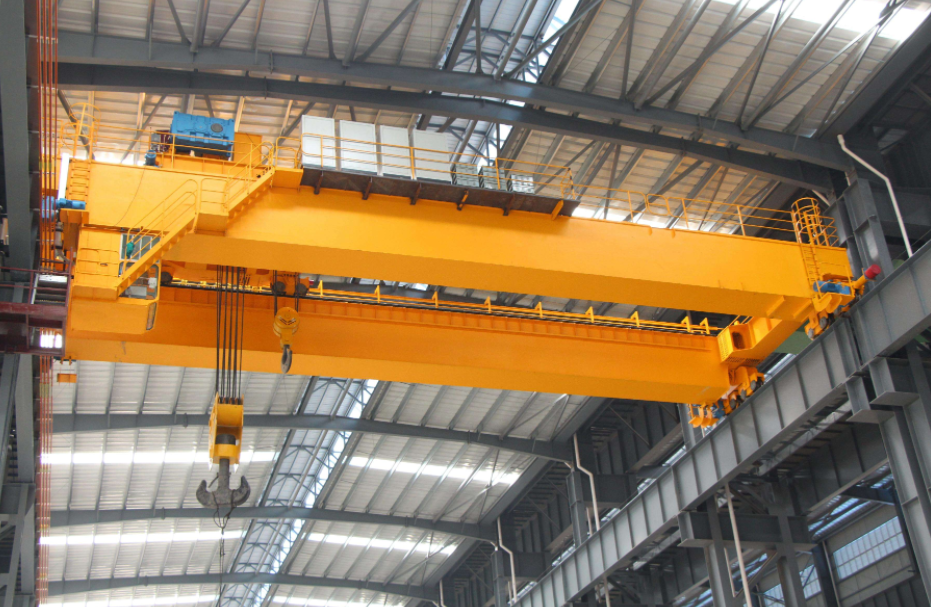How to Minimize Swing During 50-Ton Bridge Crane Lifting
- blog@ellsenbridgecrane.com
- Dec 30, 2024
- 4 min read
Efficient and safe operation of a 50-ton bridge crane requires minimizing load swing. Swinging loads can jeopardize workplace safety, reduce precision, and slow down operations. This article explores key strategies and techniques to minimize swing during 50-ton bridge crane lifting, ensuring optimal safety and productivity.

Understanding Load Swing
Load swing refers to the oscillating motion of a crane’s suspended load caused by inertia, operator error, or external factors like wind. Swinging can lead to unstable loads, making it challenging to position them accurately and risking collisions or accidents.
Causes of Load Swing
Several factors contribute to load swing during 50 ton bridge crane operation:
Abrupt Movements: Sudden starts, stops, or directional changes by the crane.
Improper Load Rigging: Uneven or unsecured load attachment.
Environmental Conditions: Wind or vibrations in the operating area.
Operator Inexperience: Lack of skill in controlling crane movements.
Inadequate Equipment Features: Cranes without anti-sway technology.
Techniques to Minimize Swing
Minimizing swing requires a combination of proper equipment handling, advanced technologies, and operator training. Here are effective strategies:
1. Use Smooth Crane Controls
One of the simplest ways to reduce swing is to operate the crane with smooth, deliberate movements. Abrupt accelerations or decelerations cause the load to oscillate. Operators should:
Start and Stop Gradually: Slowly increase or decrease the crane’s speed when moving loads.
Avoid Sudden Direction Changes: Allow the load to stabilize before switching directions.
Utilize Precision Controls: Modern cranes often feature precision control systems for smooth operation.
2. Proper Rigging Practices
The way a load is rigged directly affects its stability. Ensuring proper rigging involves:
Balancing the Load: Attach the load at its center of gravity to prevent uneven weight distribution.
Using Appropriate Slings and Hooks: Ensure rigging equipment is suitable for the load’s weight and shape.
Double-Check Attachments: Confirm that all rigging connections are secure before lifting.
3. Implement Anti-Sway Technology
Modern bridge crane for sale is often equipped with anti-sway systems. These systems use sensors and control algorithms to counteract swing by adjusting crane movements in real-time. Benefits include:
Increased Precision: Enables more accurate load placement.
Enhanced Safety: Reduces the likelihood of accidents.
Operator Ease: Simplifies the operator’s task by automatically compensating for swing.
If your crane lacks built-in anti-sway technology, consider retrofitting the system or upgrading the equipment.

4. Operator Training and Certification
Skilled operators are critical for minimizing load swing. Comprehensive training programs should cover:
Understanding Crane Dynamics: Operators must grasp how inertia and momentum affect loads.
Control Techniques: Training in the use of crane controls to achieve smooth movements.
Emergency Procedures: Knowing how to react to unexpected swing or instability.
Certified operators are not only safer but also more efficient, reducing overall operation time.
5. Environmental Considerations
External conditions such as wind or vibrations can amplify load swing. To mitigate these effects:
Monitor Weather Conditions: Avoid lifting operations during high winds.
Secure the Operating Area: Minimize environmental vibrations by stabilizing nearby equipment.
Use Wind Indicators: Install wind gauges to provide real-time feedback.
6. Maintain the Crane and Rigging Equipment
Regular maintenance ensures the crane operates as intended, reducing the chances of swing caused by equipment malfunction. Maintenance tips include:
Inspect Rigging Gear: Check for wear and tear on slings, hooks, and shackles.
Evaluate Crane Components: Regularly assess the crane’s brakes, hoist, and trolley systems.
Calibrate Controls: Ensure that control systems function smoothly and responsively.
7. Load Testing and Simulation
Before handling a heavy load, conduct a trial run or load test to assess potential swing issues. Simulation software can also help:
Predict Load Behavior: Identify how the load will move during the lift.
Optimize Lift Plans: Develop strategies to minimize swing based on the test results.
8. Use Taglines
Taglines are ropes attached to the load to provide additional control. Ground personnel can use taglines to:
Stabilize the Load: Counteract swing during the lift.
Guide the Load: Help position the load precisely.
Ensure Safety: Keep workers at a safe distance from the load.
9. Plan the Lift Carefully
Proper planning reduces the risk of swing. A detailed lift plan should include:
Load Characteristics: Understand the load’s weight, dimensions, and center of gravity.
Path of Movement: Identify and clear the intended path to avoid obstacles.
Communication Protocols: Establish clear signals between the operator and ground crew.
10. Monitor and Adjust in Real-Time
During the lift, operators should continuously monitor the load’s behavior and make real-time adjustments. This involves:
Observing Load Swing: Watch for signs of oscillation and correct movements as needed.
Coordinating with Ground Crew: Maintain constant communication to ensure everyone’s actions are synchronized.
Utilizing Cameras and Sensors: Advanced systems can provide a better view of the load, improving control.
Conclusion
Minimizing swing during 50-ton bridge crane operations is essential for maintaining safety, precision, and efficiency. By employing smooth control techniques, proper rigging practices, anti-sway technology, and comprehensive operator training, swing can be significantly reduced. Environmental awareness, equipment maintenance, and meticulous planning further enhance stability and ensure successful lifting operations. Investing in these practices not only reduces risks but also optimizes crane performance, making your workplace safer and more productive.








Comments